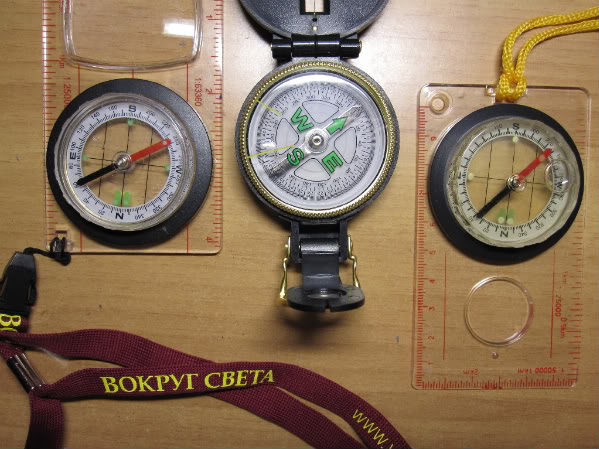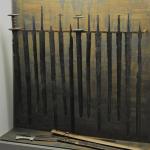You’ll excuse me, perhaps this question will seem silly to many. But today I, as a person studying geography, was very puzzled.
It was like that.
I recently downloaded a quiz game on my phone, there is a question: "Where does the red compass needle show?". I note with full confidence the answer “North” and wait until the signal of the correct answer lights up. I'm waiting. Suddenly I see that the answer is wrong, and the red arrow, it turns out, is pointing to the south! I understand that I don’t understand anything at all! All my life I was sure of the opposite, still more than once guided by the compass and always went out the right side. I am writing to my friend, and we begin to be perplexed together.
It is also useful to pay attention to wind directions. For example, some areas are known to have winds that blow from the west. If you hike in such an area, even if the wind is not blowing, you can often observe results, such as pine trees, which are more compact on the western side.
We all heard the saying that moss grows on the north side of trees. Why not check if this is true in your area? If your path crosses or is parallel to a stream or river, pay attention to the direction in which it flows. Does it flow east or northwest?
I began to search on the Internet, it turns out I'm not the only one whose minds excite this question. On several sites, including "Mail.ru Replies," everyone responds with full confidence that red is south.

In general, something like that, and it turns out that those who do not know that red is south, did not learn geography at school.
Aware, reduce lost time and disorientation, and also make your vacation more useful. Wristwatch as a compass: a clock with a clockwork can be used as a homemade compass. If the correct time is set, simply indicate the hour hand in the sun, and in this position the point halfway between the current hour and 12 will be south. In the reverse order, the compass can act like a clock.
Northern Star: In the Northern Hemisphere, polarism is visible year-round. Drawing. Approximately the distance to the North Star from the Ursa Major is 5 times greater than the distance between the two index stars forming the non-manual side of the cup. Ursa Major revolves around Polaris. The northern star can be used to measure declination. At night, place two sticks in the ground, aligned with the North Star, with a higher north to shorter. Set the compass dial to 360 and point the north direction arrow to a longer stick.
Offended, I decided to still find the answer experimentally, found my collection of compasses. (They are all serviceable - I store them in different parts of the room so that they do not demagnetize. I put them next to them for photos only).
What I saw puzzled me even more.

Look at the compass needle and notice the difference between its support and true north, the difference is declination. In the Northern Hemisphere, latitude is obtained by measuring the height of polarism. At the equator, the North Star is on the horizon, making an angle or “height” of 0 degrees. In other words, in the northern hemisphere, if you know your latitude, you can use this as an angle from the horizon to find the northern star. To measure your latitude, hover over the "Northern Star", then measure the angle that the stick makes from a horizontal horizon.
* on the middle compass, the letter S means "SOUTH" - SOUTH
In general, as far as I know (and I KNOW), the Earth’s true north magnetic pole is located in the Pacific Ocean, near Antarctica, and the true south pole is in the area of \u200b\u200bthe Canadian Arctic archipelago. Then it is logical that the red arrow shows the true south pole and, accordingly, geographical NORTH. But people speak differently, even questions on this topic are compiled ...
Please note that some compasses include a tilt sensor with which you can easily measure the angle. Define East and West through a shadow: To define east and west, place a stick in the ground so that you can see its shadow. Make sure the shadow is selected on level ground without a brush. Mark the tip of the shadow with pebbles or a scratch in the dirt; try to make the mark as small as possible to pinpoint the tip of the shadow. Mark the new position of the tip of the shadow with another small object or scratch.
Connect the two shadow marks with a straight line, and you have an east-west line approximation. The stand with the first sign on your left and the second on your right, and you will come across true north. Half-data gives more accurate approximations. These devices are useful but do not replace knowledge of the basics of orientation and navigation using a compass and map.
So who is still right? My friend and I, my compasses (and at the same time the editors of the magazine "Around the World"), or the compilers of the quiz and numerous Internet users ?!
Dear community members. Please do not swear, but just explain to me what's the matter ...
For some reason, in society it is believed that only men become fishermen, mushroom pickers, berry-growers and just lovers of long-distance travel. What kind of inequality is this !? Are we ladies worse or weaker? Or do we not want to escape for at least a couple of days from all these pots, washing machines and irons, and mother-in-law teachings? Everything has been decided; we are going on a hike the next vacation. You just need to remember how to use the compass correctly, or learn it again, and go. Well, for the job!
Never rely solely on yourself and do not allow yourself to depend on such equipment. The tops of pines tend to descend to the north. If you lose your way, keep a cool head - a cool head can do a lot, no one is cracking anything. Note that lost people tend to wander in circles; as such, first of all, do not run aimlessly. Stop first, relax and think, then look at a familiar landmark or climb a tree or hill to try to find it.
Evaluate the time you traveled and the remaining daylight to help you figure out how far you traveled. If possible, consult your compass, if this is not possible, pay attention to the sunset or sunrise that points east and west, or use a watch as a compass. If it gets dark, it is best to stay in place, as such, creating a kindling fire, which makes it easier for others to find you and allows you to stay warm. At night, find the North Star and mark this direction on earth to guide you in daylight.
Why do I need a compass, and what does it consist of?
Clear business, so as not to get lost in the campaign, we were told about this at school. If someone has forgotten, then our magnetic guide consists of a bulb, a red and blue magnetic arrow, worn on a spire and brakes - a lever fixing the arrow. The top of the flask is covered with glass, and numbers indicating the degree of deviation are placed along the very edge of the circumference of the top wall of the flask. It is also called azimuth.
Estimating the remaining daylight: if you see the sun and the horizon, you can estimate the remaining daylight. To do this, raise your hand so that the index finger just touches the bottom of the sun. Then count the amount of finger width on the horizon. Each finger costs about 15 minutes. For example, if you can place eight fingers between the bottom of the sun and the top of the horizon, about two hours of daylight remain. Please note that this trick doesn’t really work when it is near one of the poles, as the sun hangs over the horizon longer in these places.
The Russian letter "C", or the English "n", or the number zero on the compass, where the blue arrow points, is the north. And the place with the Russian letter "U", the English "z", or the number 180, where the red compass needle shows, is the south. Accordingly, the line drawn perpendicularly will point west to the left and east to the right. That’s all the trick regarding the composition and direction of the compass needle, now we turn to a practical lesson, that is, orientation to the terrain.
If you crave and cannot find water, suck a pebble or button, this will reduce dryness. Make a sundial from a piece of a stick stuck in the ground, where the sun's rays can cast a shadow from the stick onto the ground. Refer to the clock to mark the clock, and then when the clock disappears or the owners leave the camp or the batteries die, you can use the sundial to tell the time.
To prevent the disease, keep your legs and inner tissue dry, your guts open, and your head cool. A warm head makes you sweat, makes you take off your hat, and then leave you in the cold. The surest way to stay healthy and healthy is to just make a move every day. Consider this statement by Soren Kierkegaard, a 19th-century Danish philosopher: First of all, do not lose your desire to walk.
How to learn how to use the compass?
First of all, while still at home, you should check the compass for performance. It is done like this. Put the device on a flat surface, wait until its arrows stop vibrating, and notice the fixation figure. Then bring something metallic to the side of the flask to set the arrows in motion again. Once this happened, quickly remove the iron object and again wait for the arrows to lock. If the number indicated by the arrows in the first and second cases is the same, then you can go camping. If there is even the slightest discrepancy between the first and second fixation of the arrows, we go to the store for a new compass.
To dry the inside of wet boots, heat the cakes in a pan or teapot or on fire and place them in boots, shaking boots from time to time. "Red at night, vacationers resting, red in the morning light of tourists." A red sunset indicates clear weather, while a red sunrise means rain and wind.
A pale yellow sky at sunset indicates wet weather. Until the rain until seven o'clock until eleven. In other words, morning rain often makes clear after lunch. Slow rain tends to last, but sudden rain is usually short. Heavy dew indicates dry weather.
Let's say that our compass is serviceable, and go to a familiar forest park or grove. Choosing an unfamiliar area for the first training session is not worth it, so as not to be disappointed and not to give up everything without having started. After all, you don’t want to get lost and live with a persistent aversion to hiking for the rest of your life?
So, firstly, as experienced travelers say, we need to “attach” to the starting point. And this point should be very extensive and recognizable. For example, a freeway, a large river, a power line, an extended clearing. So you can always easily go back, even if slightly and deviate from the original route.
In the northern sky, Ursa Major is one of the most famous asterisms of the constellation Ursa Major. When the Earth moves around the Sun, the angle of our view of the Ursa Major changes and, therefore, is different for each season. When working with bearings, it is necessary to take into account the tendency and how this affects the frame bearings and magnetic bearings. Remember that this is simply a matter of subtracting the eastern declination from the card designed to convert it into a magnetic bearing, and the question of adding a western declination.
Of course, when converting a magnetic bearing into a carrier card, the opposite rule applies. Remember that the magnetic compass needle is for field use and is never used on a map. Also remember that the top of the map is always in the north, so when you accept the cards, always turn the compass case to indicate the approximate arrow at the top of the map.
Assume that the selected anchor point is a freeway. Slightly, take a few steps away from her in the direction in which you planned to go, and turn to face the highway. And get up so that the desired path and freeway are approximately perpendicular to each other. Now slowly turn the instrument until the direction of the compass needle coincides with the north-south direction. Attention, while holding the compass should be strictly horizontal so that the arrows do not cling to the bottom or glass of the bulb. For greater fidelity, it can be put on a stump or directly on the ground.
Of course, a compass is not the only thing that helps you stay oriented in the rear. Always study the map before entering unfamiliar territory. In the field always carry a map and pay attention to the environment, and also use indicators of the natural direction, such as shadows, stars, wind and landmarks.
As you know, the magnetic compass does not point exactly to the north, since the magnetic poles do not lie exactly at the geographic poles. The reason for this is that the axis of the magnetic dipole, which can be imagined in the earth, is not parallel to the axis of rotation of the Earth. In addition, the magnetic compass does not work properly if there is too much metal nearby - for example, on a metal submarine. With a gyroscope, you have no such problems.
Next, we take a ruler, or a pencil, or a straight stick lying nearby and draw a straight line through the center of the compass towards your return, that is, towards the highway, and remember the number that the end of the stick or ruler will indicate. This will be the direction in which you will return home. And that figure, which indicates the end of the stick, opposite the return, and there will be the route that you should  stick deep into the forest. Do not forget, the countdown comes from zero or the letter “c” clockwise. And where the red compass needle points is the south and the number 180.
stick deep into the forest. Do not forget, the countdown comes from zero or the letter “c” clockwise. And where the red compass needle points is the south and the number 180.
The gyrocompass function is based on the conservation of pulses, more precisely on a rotational pulse. Every body has a pulse. This is an amount consisting of body weight and its speed. If the body has zero speed, therefore, if it is at rest, its momentum is equal to zero. While no forces act on the body, it retains its momentum - the momentum is preserved. When a certain speed is set in motion in a certain direction, the spacecraft will move at that speed in the direction of impact until a force is applied to it.
Moving vehicles come to the ground, usually quite quickly again at a standstill, but there is another force that affects: friction, braking of the vehicle. However, you can clearly sense the body's effort to maintain momentum while sitting in the vehicle and braking it. Although the car is slower, its own body is still moving in the direction of movement, depending on the speed and spontaneity of the deceleration, either its own muscle strength or the next wall stops this movement.
After strolling through the forest and gathering back, take the compass so that the line drawn through the center of the instrument and the return digit indicates the direction straight forward. Imagine that this direction starts from the center of your body, and strikes into the distance with an endless direct beam. Having found this position, slowly turn around its axis until the blue arrow points to the number 0 or the letter “c”. Once this has happened, know that you are facing the direction you have to go.
Rotations are also connected to a pulse - a rotational pulse. Therefore, for rotational movements there is also a set for saving, a set for saving pulses of rotation: a rotating body would like to maintain its angular momentum. This means that he wants to maintain both speed and the direction of his angular momentum. The direction of the rotation pulse is fixed so that it is perpendicular to the rotational movement and indicates the direction of rotation. Therefore, in the case of a rotating wheel, the torque indicates the direction of the axis of the wheel.
That’s all wisdom, how to learn how to use the compass correctly, have a nice trip and a happy trip.


